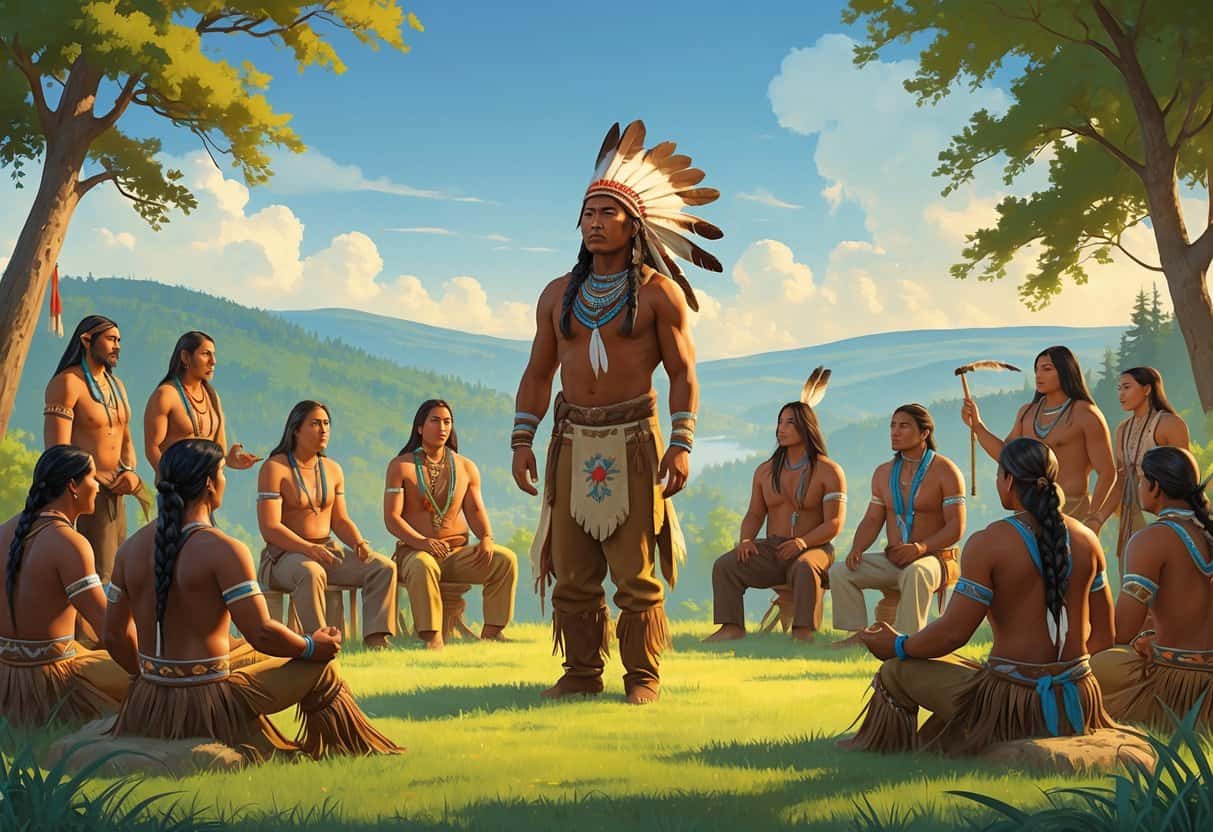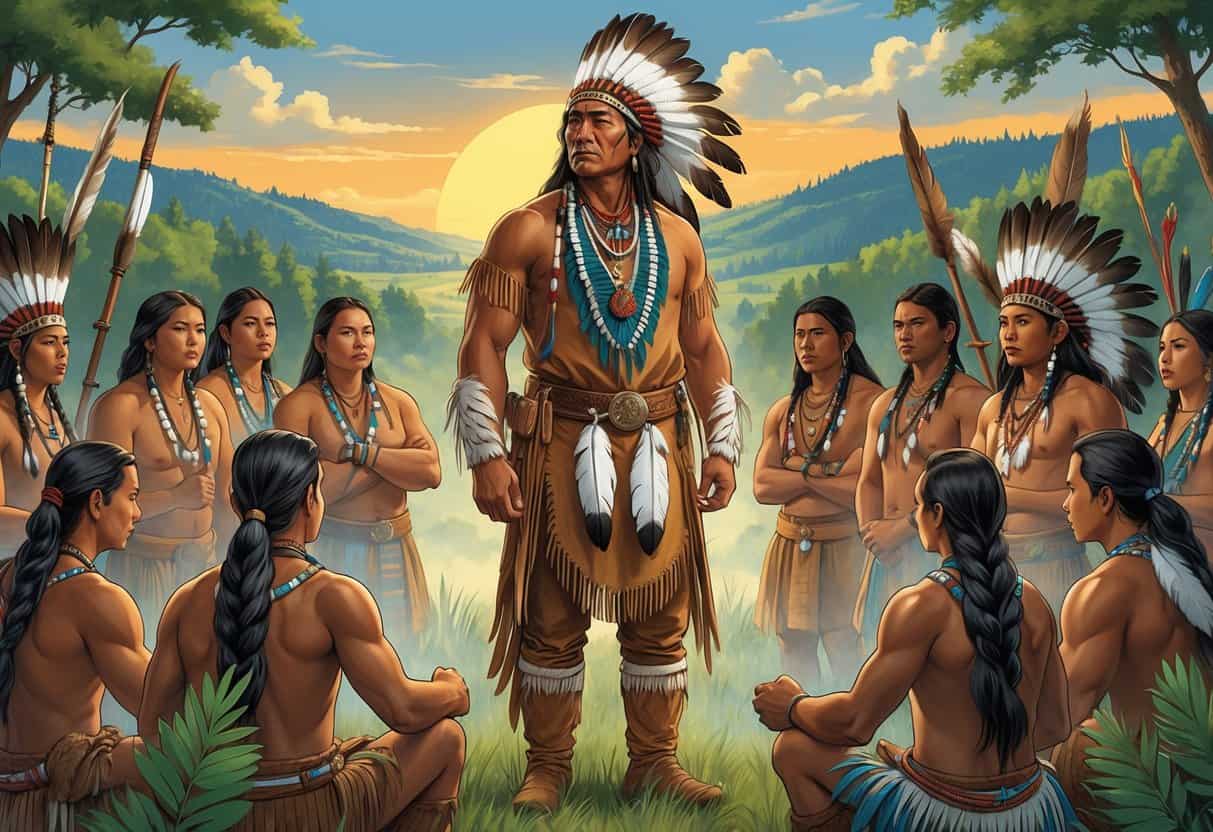Tecumseh was a Shawnee leader who dreamed of uniting different Native American tribes to protect their lands and cultures from U.S. expansion.
His vision was to create a strong confederacy that could resist losing their territories and keep their traditional way of life.
This effort mattered because tribes were under constant pressure to abandon their customs and land to settlers.

Tecumseh’s goal wasn’t just about fighting. He wanted to restore pride and unity among Indigenous peoples.
His work laid a foundation for future Native American activism. It showed the importance of standing together when things get tough.
Key Takeaways
- Tecumseh sought to unite tribes into a single confederacy.
- His vision aimed to protect Native lands and culture.
- His leadership influenced later Native American resistance efforts.
Tecumseh’s Vision and the Pan-Indian Movement

Tecumseh built a movement to unite Native American tribes against settlers.
His leadership, the spiritual influence of his brother Tenskwatawa, and their shared beliefs shaped the confederacy’s goals.
Tecumseh’s Leadership and His Call for Unity
Tecumseh was a Shawnee chief who saw the growing threat from American settlers.
He traveled far and wide, urging tribes to join forces. His message? Unite, or risk losing everything.
His leadership was rooted in strength and respect. Tecumseh spoke with real courage, convincing others that unity was the only way forward.
His calls weren’t just political—they were about protecting a way of life.
The Role of Tenskwatawa and Prophetstown
Tenskwatawa, Tecumseh’s brother, was called the Prophet.
He led a religious revival that inspired many Native Americans. His visions urged people to reject European customs and return to traditional ways.
Prophetstown became their main settlement and a symbol of unity and pride.
It was a meeting place for tribes and a base for resistance planning. This community was both spiritual and political at its core.
Spiritual Foundations: The Great Spirit and Cultural Heritage
Belief in the Great Spirit was at the heart of their movement.
Tecumseh and Tenskwatawa taught that respecting the Great Spirit and holding on to cultural traditions would make them stronger.
Spiritual renewal inspired political action. Preserving culture mattered just as much as defending land.
This unity was tied tightly to faith and shared history.
Formation and Goals of the Confederacy
Tecumseh worked to form a confederacy—a union of different tribes.
The main goal? Stop settlers from taking Native lands.
This confederacy brought together tribes like the Shawnee, Miami, and Delaware.
Tecumseh wanted this group to act as one nation, protecting all tribal lands together. That was a new idea in Native American politics.
Historical Context and Challenges to Unity
Tecumseh’s efforts happened in a time of rapid change and conflict.
There was pressure from American land growth, government actions, mixed tribal reactions, and issues involving African Americans and slavery. All of this made unity tough.
Westward Expansion and the Struggle for Land
American settlers and the government kept pushing west.
Leaders like Thomas Jefferson saw Native lands as obstacles after the Declaration of Independence.
The federal government often ignored Native claims, leading to more conflict and land loss.
The Indian Removal Act, signed by Andrew Jackson, forced many tribes off their ancestral lands.
This caused suffering and destroyed traditional ways of life. Violence and massacres happened during these forced moves, deepening mistrust.
Tecumseh tried to stop this expansion by uniting tribes. But not all tribes agreed about fighting settlers or making land deals.
Unity was never simple.
The Impact of U.S. Policies and Leaders
Leaders like James Madison, Alexander Hamilton, and John Adams shaped early U.S. policies toward Native peoples.
Many saw Native tribes as obstacles to progress.
The government negotiated treaties that usually favored settlers. Promises and military force were both used to push Native Americans off their land.
Tecumseh opposed these policies and wanted a confederacy to fight back.
But government efforts to divide tribes and use diplomacy against them made things harder.
Resistance and Support From Other Indigenous Peoples
Tribes had different views about Tecumseh’s vision.
Some agreed, seeing strength in numbers. Others stayed neutral or sided with Americans because of old rivalries or hopes for peace.
This division made a strong confederacy tough to build.
Tribes faced harsh realities: loss of land, resources, and the fear that more war would only make things worse.
Tecumseh’s call for joint action challenged traditional tribal independence. Cooperation on this scale was something new.
Role of African Americans and Slavery
African Americans and slavery influenced Tecumseh’s world, too.
Some African Americans joined Native tribes or supported Tecumseh, hoping for freedom or better lives.
Others were caught between slavery and Native societies, making alliances complicated.
At the same time, American leaders were expanding slavery along with land.
This expansion was tied to territory disputes and rising tensions.
Tecumseh’s confederacy didn’t directly address slavery, but these issues shaped the world he was fighting in.
Tecumseh’s Legacy in Wars and American History
Tecumseh shaped key conflicts like the War of 1812.
He died fighting for his cause at the Battle of the Thames. His influence reached into later American history, including the Civil War and the forced removal of Native Americans.
Tecumseh in the War of 1812
Tecumseh was a major Native American leader in the War of 1812.
He joined forces with the British to resist American expansion into Native lands.
Tecumseh’s military skills helped the British win the Siege of Detroit in 1812.
He worked to unite many Native tribes to protect their lands and culture.
His alliance with the British was all about stopping U.S. westward growth.
The Battle of the Thames and Tecumseh’s Death
The Battle of the Thames happened in 1813 in what’s now Ontario.
American forces defeated the British and their Native allies.
Tecumseh was killed in this battle, ending his effort to build a united Native front.
His death was a huge loss for Native resistance.
Without him, the confederacy fell apart quickly. The U.S. pushed further into Native territory with less organized opposition.
Influence on the Civil War, Trail of Tears, and Beyond
Tecumseh’s vision of unity influenced future generations.
During the Civil War, some Native tribes remembered his call for unity and sovereignty when choosing sides.
Later, during the Trail of Tears in the 1830s, many Native groups faced forced removal from their lands.
Tecumseh’s efforts were remembered as a symbol of resistance.
His legacy lives on as one of the first Native leaders who tried to defend his people’s land and rights in a time of upheaval.
Modern Interpretations and Lasting Impact
Tecumseh’s ideas changed how many people see Native American unity and leadership.
His challenge to U.S. expansion and vision for a united Native nation reshaped leadership views and highlighted ongoing struggles.
Understanding Tecumseh’s Influence on American Culture
Tecumseh is remembered beyond Native history.
His efforts to unite tribes threatened U.S. policies like the Louisiana Purchase and challenged the government’s approach to Native lands.
His image shows up in American culture through stories and sometimes in schools, as a leader fighting for rights and land.
Tecumseh’s resistance became a symbol against westward expansion and the free-market push for land.
His leadership showed Native resilience, and it’s surprising how often his role is overlooked in early American history and culture.
Perspectives on Native American Leadership and Survival
Tecumseh’s leadership style stood out.
He worked to form a confederacy, focusing on unity over individual group interests.
This was a direct answer to the divide-and-conquer tactics of the U.S. government.
His vision emphasized a shared Native identity, not just tribal ties.
Survival meant adapting to changing political forces while trying to save native culture.
Tecumseh’s role shows how leaders balanced cultural survival with political action.
It’s a reminder of why leadership was crucial for Native Americans facing U.S. expansion.
Current Scholarship, Women’s Rights, and Ongoing Challenges
Recent research looks at Tecumseh’s vision with more complexity. Scholars analyze his political goals alongside cultural revival.
They’ve also started to include the roles of Native women leaders who supported his efforts. Women’s rights in Native communities were connected to broader survival strategies.
You see ongoing challenges, like how Native stories are told in schools and media. Some Google articles and history books now include Tecumseh’s story more fully.
Still, debates continue about how Native histories fit into the national narrative. It’s a reminder that Tecumseh’s legacy is tangled up in today’s bigger conversations about history, rights, and recognition.